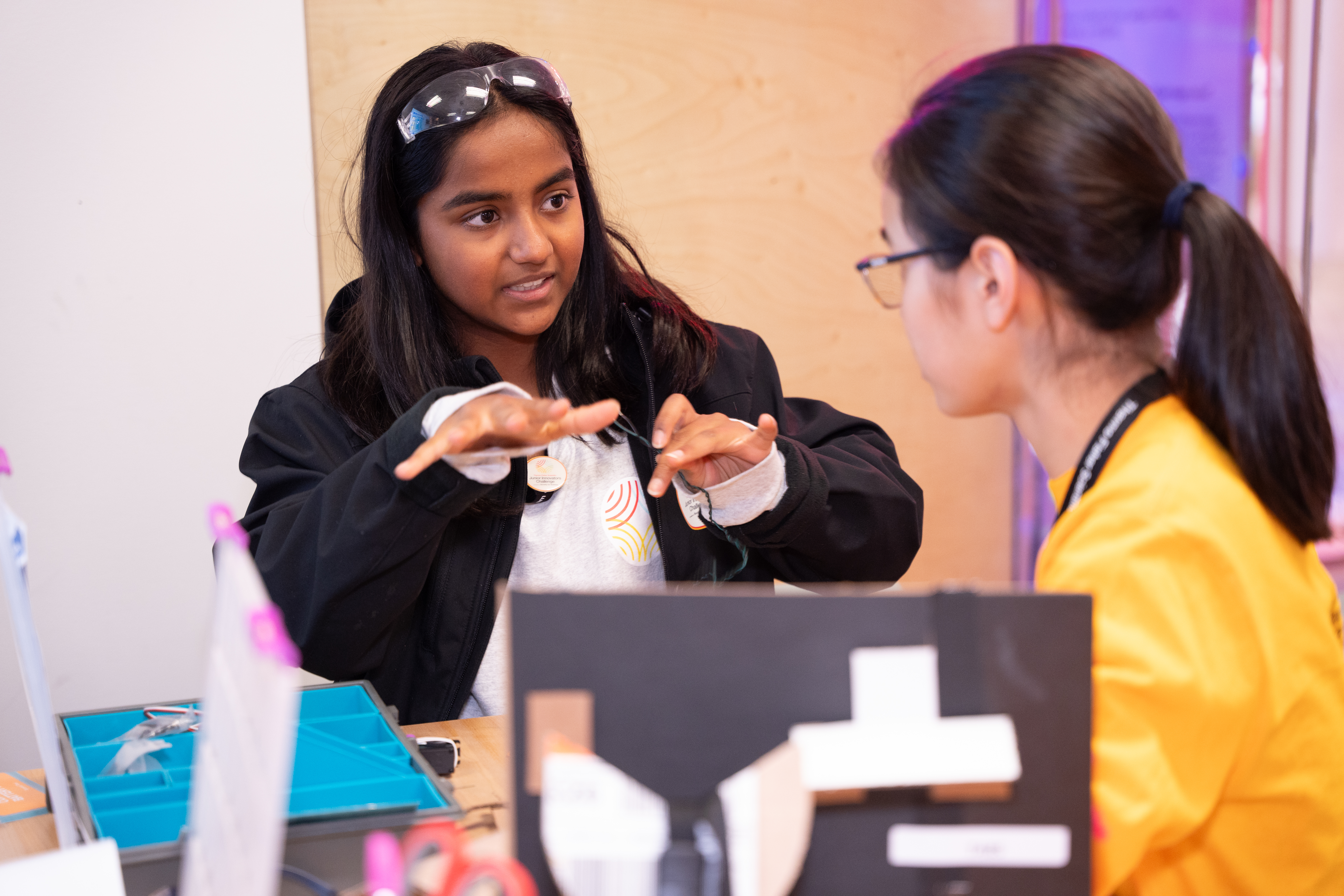By Annalisa Alpaugh
Senior Manager, Corporate Social Responsibility
Global Communications

“I just found it so fascinating—it was wonderful to hear about how things worked,” she recalled. “I still remember it years later, because you know my dad's a very, very good teacher.”
Shanya’s star in the STEM universe has been rising ever since. Last November, a few months into seventh grade, she bested over 60,000 competitors in the 2023 Thermo Fisher Scientific Junior Innovators Challenge (JIC) by developing a novel fire detection system that is faster and more accurate than traditional smoke detectors. The competition, hosted by Society for Science, is the nation’s premier science, technology, engineering and math (STEM) competition for middle schoolers, which promotes equitable access to hands-on STEM learning experiences. Shanya’s fire detector is now attracting attention from major security companies and the U.S. Fire Administration.
There are No Dumb Questions

Recently, the Silicon Valley native decided to clear her extracurricular schedule—everything from academic programs and sports to art classes and dance—because she thought the rigor was eroding her sense of purpose.
“Where I am,” said Shanya, “everything you do is for a resume; nothing is about passion.”
Now, she uses the extra time and freedom to pursue any topic that piques her interest.
One of those topics is fire safety.
Last year, the restaurant behind Shanya’s house burned down. Thankfully, there were no casualties, but the event triggered fear and anxiety at home.
"Ever since that, my mother was ever so cautious about house fires, and I would often have to go back into the house and check if the kitchen burners were running just as we were leaving,” she recalled to Fox News. Shanya said she remains more of a pragmatist, because “it's just easier to not focus on what could go wrong,” though she now appreciates what an all-encompassing loss a fire could be.
“I had never really experienced something like that before,” Shanya told the Washington Post. “I decided to do something about it.”
She started by searching for answers to a series of questions she had about the neighborhood tragedy: Why wasn’t the fire caught earlier if the restaurant was equipped with smoke detectors? Why are detectors designed to detect smoke when heat comes first? Is there a way to engineer a system that detects heat from an unattended fire?

But testing this hypothesis required a skill she didn’t have.
“It was kind of surreal to find myself actually trying to teach myself to code,” Shanya said. She’d previously avoided programming because it was so cliche in her community. But her drive to solve this issue changed her mind.
After several months of sometimes frustrating trial-and-error research, Shanya’s prototype took shape. The device could detect the presence of warm objects, such as horizontally moving humans, with 98 percent accuracy. It detected hot objects, such as a lit gas stove burner, with 97 percent accuracy. Most importantly, the system could detect an unattended hot object with 97 percent accuracy and text an alert to the user. That is better than traditional smoke detectors, which operate at a rate of about 82-94 percent accuracy.ᶦᵛ
A Winning Idea
Shanya decided to enter the fire detector in her local science fair—and won. Then, she won her regional and state fairs.
“[Seeing] people outside of my family actually caring about this really just gave me confidence,” Shanya said. “Like, oh, this probably means something, and this can probably go somewhere.”
Because her state science fair was affiliated with the national nonprofit Society for Science, Shanya’s win made her eligible to apply for the Thermo Fisher Scientific JIC. Through the nationwide competition, a panel of judges selected Shanya as one of 300 semifinalists, and later, a top 30 finalist—which earned her an invitation to compete in Thermo Fisher JIC Finals Week in Washington, DC.
Shanya’s project wowed the judges. In addition to her formal defense of her project, Shanya and other finalists were evaluated on a series of project-based team challenges, which showcased their critical thinking, communication, creativity, collaboration and leadership skills.

At the final awards ceremony at Washington D.C.’s Kennedy Center, Shanya was elated when her name was called for the competition’s top prize, the $25,000 Thermo Fisher Scientific Aspiring Scientists Cultivating Exciting New Discoveries (ASCEND) Award.
Shanya described the moment she won as suspenseful and surreal, but affirming. “Now I want to keep on moving forward because I think I’ve proved to myself that I can,” she told a reporter after the competition.
Sharing Her Invention with the World
Shanya now hopes to commercialize her fire detector. Thermo Fisher offered some expert guidance on the path forward.
Shanya doesn’t want to patent her device because she refuses to impede anyone’s access to it. She wants it to save as many lives and buildings as possible. In fact, Shanya is creating a website with open-source code so the public can share data sets of thermal images and crowdsource improved software before the device goes to market.
Beyond an appetite for innovation, the Thermo Fisher JIC earned Shanya credibility with her peers. She wants to use it to share her love of STEM with young people, especially those who lack access and exposure to the high-quality, hands-on learning opportunities she’s enjoyed.
“You don't want … a lack of STEM education in your area to stop you from becoming a Nobel Prize-winning scientist, right?” she said.
The dream will start in her own back yard, or, more precisely, her garage, where Shanya plans to lead free STEM classes.
“Inviting everyone to come free of cost, that would just really spark, you know, a passion for so many different people.”
Her biggest piece of advice to young learners in STEM and beyond? Don’t be afraid to ask questions, she said.
“Once you ask that question and then try to figure out the answer, you're definitely going to learn more about yourself.”

